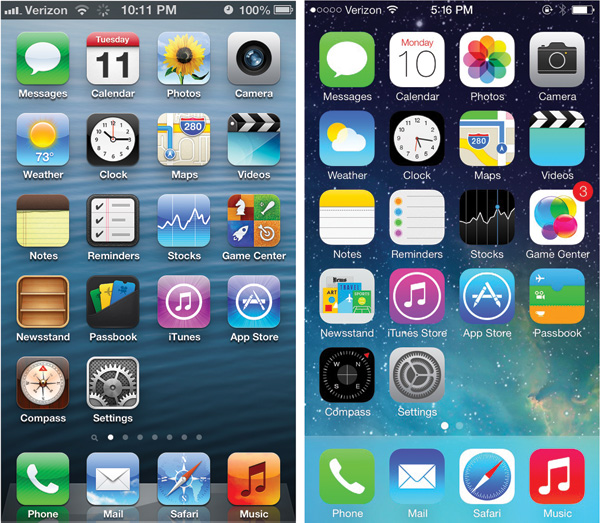Apple’s invitation to their September 10th, 2013 special event announced that it would “brighten everyone’s day.” The bright, colorful imagery included on the invitation was an obvious tribute to Sir Jony Ive’s radical new palette for iOS 7, as well as a potential hat tip to the rumored multi-hued iPhone 5C phones. This article went to press prior to the big unveil, but it doesn’t take a crystal ball to know that iOS 7 is part of this fall’s big Apple lineup. A lot of new stuff is coming in this release that healthcare marketers—especially those with iOS apps—need to know about.
What’s New?
Apple has had an iOS 7 preview up on their website (http://www.apple.com/ios) since they announced it at their Worldwide Developers Conference (WWDC) back in June. One of the most striking updates is a complete redesign of iOS’ look and feel. iOS 7 has stripped, flattened out and become much lighter. Gone are all skeuomorphic references to real world objects (like the leather binding in Calendar), replaced by a much brighter color palette and more elegant typographic choices (see Figure 1 below). Apple’s microsite also calls out a number of key new and revised features and apps. Let’s dig into what all of this means from a healthcare marketer’s perspective.

iOS 6 (right) versus iOS 7’s (left) newly designed icons and color palette.
New Look and Feel
Like most Apple updates, old apps will work fine on the new OS. However, the apps will look dated once users get used to the cleaner look of iOS 7 and some new interaction styles can be considered for future app updates. For example, the Apple Transition Guide states:
Most importantly, though, Apple is giving developers a couple of tips for building “crisp, beautiful UI and fluid motion” for iOS 7 so that third-party apps match Apple’s own style. This means apps should, whenever possible, take advantage of the whole screen, and developers should reconsider the use of insets and visual frames and instead let the content “extend to the edges of the screen.” They should also “reconsider visual indicators of physicality and realism” and avoid bezels, gradients and drop shadows, because that “sometimes leads to heavier UI elements that can overpower the content.” The UI, Apple says, should just “play a supporting role.” This also means apps should “provide clarity” (that is plenty of white space) and use color to simplify their UI.
So, yes, this means you should redesign your apps to look as clean as possible on iOS 7. If your app doesn’t need other updates, it will continue to run fine if you don’t redesign it. When updating apps to work on iOS 7, developers will want to keep iOS 6 compatibility in mind. Unfortunately, this means testing on both platforms. However, developers should be able to stick to one code base if they use Apple’s controls correctly. Apple’s Transition Guide is available to all developers and has also been shared online at bit.ly/apple-ios7-guide.
Key Feature Implications
New features coming in iOS 7 might have an impact on your apps or other programs. Here’s a quick feature-by-feature review.
Passbook Scanner
Apple’s Passbook app is getting an update to include the ability to scan codes. Although not much is yet known about it, it is believed that this will introduce a QR Scanner to iOS for the first time. Although this may be limited to scanning on-screen or print codes to add cards to Passbook, there are plenty of opportunities to use them for things like co-pay. See www.klick.com/health/news/blog/patient-solutions/apple-ios-passbook-for-pharma-copay/.
AirDrop Sharing
AirDrop has been part of Apple’s desktop OS since the release of Mac OS X “Lion.” This so-called ad hoc sharing feature enables two Macs on the same Wi-Fi network to very easily share files back and forth without needing to know any configuration information or to do any setup beyond opening an AirDrop window in the Finder. AirDrop on iOS works very similarly, extending the Share menu found in many iOS apps into an ad hoc sharing network between phones on Wi-Fi or Bluetooth. This could enable easy sharing of videos by HCPs to patients (e.g., a video on how to do perform an injection), sharing Passbook co-pay cards, sending materials to HCPs during details or conferences (with no economic value so as to avoid Sunshine Act implications), etc.
Keychain Passwords
Users are accustomed to their browsers offering to save usernames and passwords on desktops. iOS 7’s Keychain brings this auto-fill functionality to the phone, including the ability to generate a strong and unique password for each service. We don’t anticipate any HIPAA issues with the technology as it is invisible to the data collector and is fully under the control of the end user. The ability to easily and securely login to websites from iOS will likely increase the number of users willing to do so, suggesting that marketers look to mobile optimizing web-based tools that they might have previously skipped. Although the details weren’t known at press time, this feature appears to rely on “iCloud Keychain,” which will likely require iCloud to be enabled (at least for syncing logins across devices).
True Multitasking
Up until the iOS 7 release, developers have only been able to leave a very limited set of tasks running in the background such as audio players, voice apps waiting for calls, background location checking, apps that use external accessories and apps waiting for notifications. Now iOS 7 brings true multitasking, meaning that developers can run virtually any type of task in the background. This unlocks a world of possibilities in the health tracking space, meaning that apps can stay running on patients’ phones and silently collect all kinds of sensor data for later analysis.
Conclusion
• If your organization is running any mobile projects it is important to consider iOS 7. Ask these questions to get an idea of your readiness:
• Is our app or offering able to handle the new look and feel of iOS 7? Or will it look dated? Can we take advantage of the new typography to provide a more attractive, and more useful, solution?
• Do the new features such as AirDrop sharing or 2D scanning open up any new possibilities for our existing apps? Or, do they make apps on the drawing board more attractive?
• Will the optional features such as true multitasking and Keychain make a difference for our users? Will we need to monitor the uptake of these technologies for future updates to our offerings?
• Are my technology suppliers on top of this update? What are they doing to support it?
Good luck and happy iOSing!




